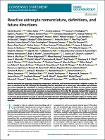| dc.identifier.citation | Escartin, C. and Galea, E. and Lakatos, A. and Oâ Callaghan, J.P. and Petzold, G.C. and Serrano-Pozo, A. and Steinhäuser, C. and Volterra, A. and Carmignoto, G. and Agarwal, A. and Allen, N.J. and Araque, A. and Barbeito, L. and Barzilai, A. and Bergles, D.E. and Bonvento, G. and Butt, A.M. and Chen, W.-T. and Cohen-Salmon, M. and Cunningham, C. and Deneen, B. and De Strooper, B. and Díaz-Castro, B. and Farina, C. and Freeman, M. and Gallo, V. and Goldman, J.E. and Goldman, S.A. and Götz, M. and Gutiérrez, A. and Haydon, P.G. and Heiland, D.H. and Hol, E.M. and Holt, M.G. and Iino, M. and Kastanenka, K.V. and Kettenmann, H. and Khakh, B.S. and Koizumi, S. and Lee, C.J. and Liddelow, S.A. and MacVicar, B.A. and Magistretti, P. and Messing, A. and Mishra, A. and Molofsky, A.V. and Murai, K.K. and Norris, C.M. and Okada, S. and Oliet, S.H.R. and Oliveira, J.F. and Panatier, A. and Parpura, V. and Pekna, M. and Pekny, M. and Pellerin, L. and Perea, G. and Pérez-Nievas, B.G. and Pfrieger, F.W. and Poskanzer, K.E. and Quintana, F.J. and Ransohoff, R.M. and Riquelme-Perez, M. and Robel, S. and Rose, C.R. and Rothstein, J.D. and Rouach, N. and Rowitch, D.H. and Semyanov, A. and Sirko, S. and Sontheimer, H. and Swanson, R.A. and Vitorica, J. and Wanner, I.-B. and Wood, L.B. and Wu, J. and Zheng, B. and Zimmer, E.R. and Zorec, R. and Sofroniew, M.V. and Verkhratsky, A., Reactive astrocyte nomenclature, definitions, and future directions, Nature Neuroscience, 24, 3, 2021, 312-325 | en |
| dc.description.abstract | Reactive astrocytes are astrocytes undergoing morphological, molecular, and functional remodeling in response to injury, disease, or infection of the CNS. Although this remodeling was first described over a century ago, uncertainties and controversies remain regarding the contribution of reactive astrocytes to CNS diseases, repair, and aging. It is also unclear whether fixed categories of reactive astrocytes exist and, if so, how to identify them. We point out the shortcomings of binary divisions of reactive astrocytes into good-vs-bad, neurotoxic-vs-neuroprotective or A1-vs-A2. We advocate, instead, that research on reactive astrocytes include assessment of multiple molecular and functional parameters—preferably in vivo—plus multivariate statistics and determination of impact on pathological hallmarks in relevant models. These guidelines may spur the discovery of astrocyte-based biomarkers as well as astrocyte-targeting therapies that abrogate detrimental actions of reactive astrocytes, potentiate their neuro- and glioprotective actions, and restore or augment their homeostatic, modulatory, and defensive functions. | en |




